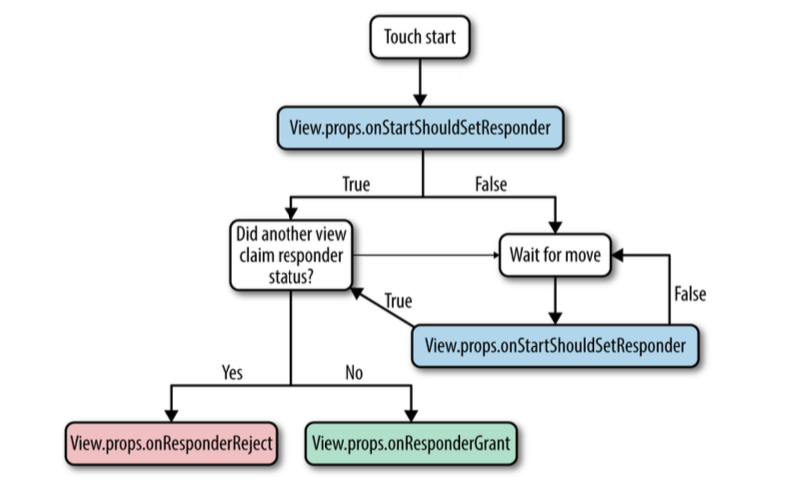2.5 Events
1.Basic events
class Touch extends Component {
handlePress(){
console.log('press');
}
handleLongPress(){
console.log('longPress');
}
render() {
return (
<TouchableHighlight
onPress={this.handlePress}
onLongPress={this.handleLongPress}>
<View>
<Text>Press me!</Text>
</View>
</TouchableHighlight>
);
}
}
1.2. <TextInput/>
class Test extends Component {
//...
//handle events
//...
render() {
return (
<TextInput
onBlur={...}
onChange={...}
onEndEditing={...}
onSelectionChange={...}
onSubmitEditing={...}
</TextInput>
);
}
}
//keyboardWillShow, keyboardDidShow, keyboardWillHide, keyboardDidHide
//keyboardWillChangeFrame, keyboardDidChangeFrame
//add the listener
var listener = DeviceEventEmitter.addListener('keyboardWillShow', (e) =>{
console.log('Event is fired!');
});
//remove the listener
listener.remove();
2.1 Lifecycle
 2.2 example
2.2 example
class Test extends Component {
/* Capture handles */
//the responder system bubbles up from the deepest component,
//a parent View wants to prevent the child from becoming responder on a touch start
handleStartShouldSetResponderCapture(evt){
return true;
}
//the responder system bubbles up from the deepest component,
//a parent View wants to prevent the child from becoming responder on a touch move
handleMoveShouldSetResponderCapture(evt){
return true;
}
/* Lifecycle handles */
//Does this view want to become responder on the start of a touch?
handleStartShouldSetResponder(evt){
return true;
}
//Called for every touch move on the View when it is not the responder:
//does this view want to "claim" touch responsiveness?
handleMoveShouldSetResponder(evt){
return true;
}
//The View is now responding for touch events.
handleResponderGrant(evt){
console.log('you are touching me');
}
//Something else is the responder right now and will not release it
handleResponderReject(evt){
console.log('please wait in line');
}
/* event handles */
//touch move
handleResponderMove(evt){
console.log('touch move at:', 'X='+evt.pageX, 'Y='+evt.pageY);
}
//touch end/up
handleResponderRelease(evt){
console.log('touch end');
}
//Something else wants to become responder. Should this view release the responder?
handleResponderTerminationRequest(evt){
return true;
}
//touch cancel
handleResponderTerminate(evt){
console.log('touch canceled');
}
render() {
return (
<View
onStartShouldSetResponderCapture={this.handleStartShouldSetResponderCapture}
onMoveShouldSetResponderCapture={this.handleMoveShouldSetResponderCapture}
onStartShouldSetResponder={this.handleStartShouldSetResponder}
onMoveShouldSetResponder={this.handleMoveShouldSetResponder}
onResponderGrant={this.handleResponderGrant}
onResponderReject={this.handleResponderReject}
onResponderMove={this.handleResponderMove}
onResponderRelease={this.handleResponderRelease}
onResponderTerminationRequest={this.handleResponderTerminationRequest}
onResponderTerminate={this.handleResponderTerminate}>
<Text>Press me!</Text>
</View>
);
}
}
2.3 evt is a synthetic touch event with the following form nativeEvent:
- changedTouches - Array of all touch events that have changed since the last event
- identifier - The ID of the touch
- locationX - The X position of the touch, relative to the element
- locationY - The Y position of the touch, relative to the element
- pageX - The X position of the touch, relative to the root element
- pageY - The Y position of the touch, relative to the root element
- target - The node id of the element receiving the touch event
- timestamp - A time identifier for the touch, useful for velocity calculation
- touches - Array of all current touches on the screen
3.1
this._panResponder = PanResponder.create({
// Ask to be the responder:
onStartShouldSetPanResponder: (evt, gestureState) => true,
onStartShouldSetPanResponderCapture: (evt, gestureState) => true,
onMoveShouldSetPanResponder: (evt, gestureState) => true,
onMoveShouldSetPanResponderCapture: (evt, gestureState) => true,
//touch start
onPanResponderGrant: (evt, gestureState) => {},
//touch move
onPanResponderMove: (evt, gestureState) => {},
onPanResponderTerminationRequest: (evt, gestureState) => true,
//touch end/up
onPanResponderRelease: (evt, gestureState) => {},
//touch cancel
onPanResponderTerminate: (evt, gestureState) => {},
onShouldBlockNativeResponder: (evt, gestureState) => true,
});
3.2 A gestureState object has the following:
- stateID - ID of the gestureState- persisted as long as there at least one touch on screen
- moveX - the latest screen coordinates of the recently-moved touch
- moveY - the latest screen coordinates of the recently-moved touch
- x0 - the screen coordinates of the responder grant
- y0 - the screen coordinates of the responder grant
- dx - accumulated distance of the gesture since the touch started
- dy - accumulated distance of the gesture since the touch started
- vx - current velocity of the gesture
- vy - current velocity of the gesture
- numberActiveTouches - Number of touches currently on screen